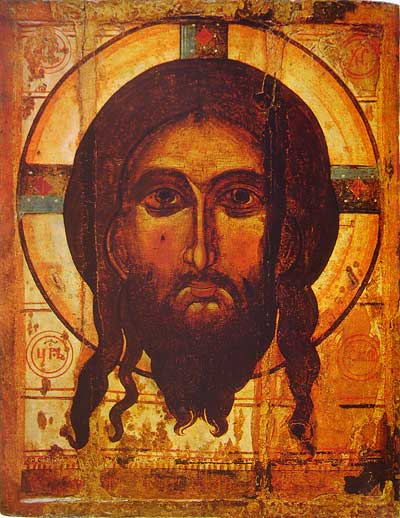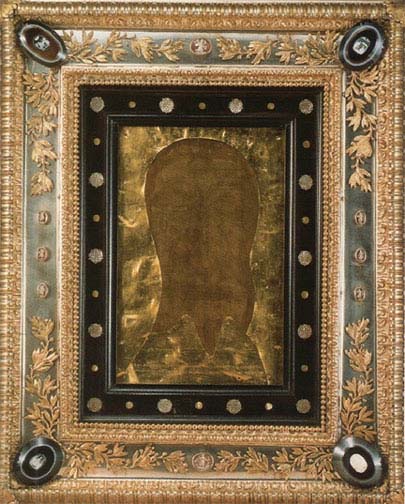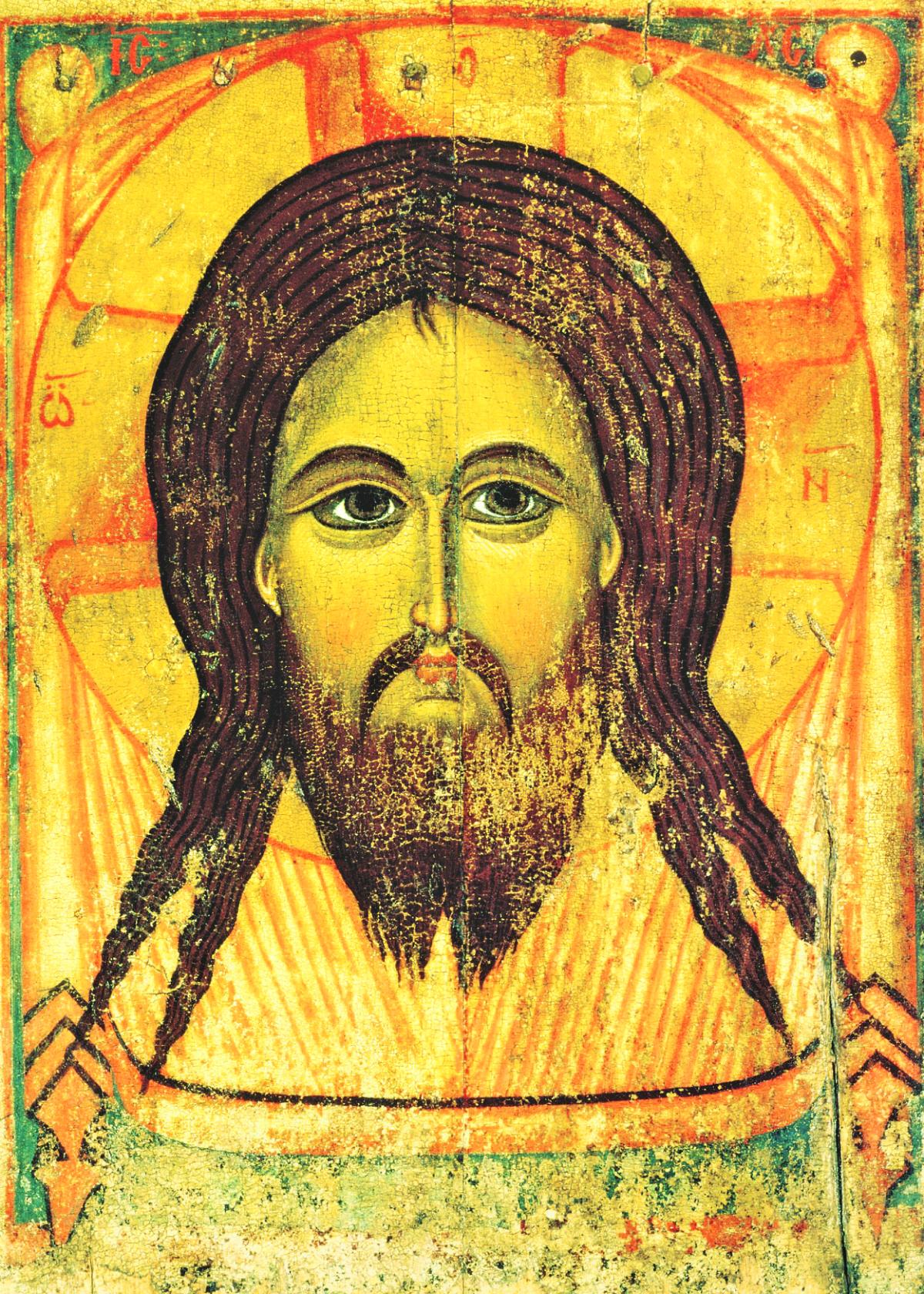
The Acheiropoieta (αχειροποιητα, "Made Without Hands") are a collective name for a variety of icons which are believed to have been created, as the name directly states, without human hands. There are many of them (as far as I know, all of either Jesus Christ or the Theotokos), and their connection is mostly in their origin, so instead of trying to describe them in general, I will shortly describe most of the most famous ones separately.
The Image of Edessa (or the Mandylion) is purported to be the first acheiropoeiton. I first heard the story of it from reading Eusebius' Ecclesiastical History, and that appears to be the first recording of the story. King Abgar of Edessa wrote a letter to Jesus, asking Him to come visit the king and heal him of a disease; Our Lord wrote a letter in response, saying that He would not come, but later one of His followers would come and heal the king. This came to pass, as Jesus' disciple Thaddeus (one of the Seventy, not one of the Twelve) visited the king and healed him. This is where the story grows less certain: some reports say that Thaddeus brought an image of Christ to the king. This image is the Mandylion. Unfortunately, the location of the original image is unknown: the latest records show that is disappeared during the French Revolution. However, there are three images relating to it: the Holy Face of Genoa, the Holy Face of San Silvestro (both of these are often considered to be copies of the Mandylion), and the Keramidion (a tile onto which the image on the Mandylion was miraculously transferred through contact -- this is thought to still exist as the Anchiskhati (ანჩისხატი)).
 A representation of the Mandylion from the Novgorod School
A representation of the Mandylion from the Novgorod School The Holy Face of Genoa (L); the Holy Face of San Silvestro (R)
The Holy Face of Genoa (L); the Holy Face of San Silvestro (R) Anchiskhati (thought to be the Keramidion)
Anchiskhati (thought to be the Keramidion)The Veil of Veronica (or Sudarium, sweat-cloth) is the cloth Veronica used to wiped the face of Christ along the Via Dolorosa (the Way of the Cross). It is believed to still exist in St. Peter's Basilica, where it is displayed every year on Passion Sunday (Palm Sunday). There are few investigations done on the Veil, so its authenticity is unknown. According to some reports, it is a very thin veil which is mostly transparent when viewed straight on, but when something is placed behind it one can see the image of Christ which is present on the veil. Another image which purports to be the Veil of Veronica is the Holy Face of Manoppello (which seems to have the same physical characteristic of sheerness as the Veil at St. Peter's), which has been receiving more interest in recent years.
The Shroud of Turin is thought to be the burial cloth of Christ. There has been immense research done on the Shroud, but there is no definite conclusion on its authenticity (though the Vatican has approved the use of the image for devotion to the Holy Face of Jesus). Some have tried linked the Shroud to the Veil of Veronica or the Mandylion. Rather than being merely an image of a face, the Shroud bears the image of the entire body of a man, and the markings on the Shroud seem to correspond with the wounds that were suffered during Christ's Crucifixion.
 The Shroud of Turin, plain and photo negative
The Shroud of Turin, plain and photo negative(See the full shroud here.)
The Uronica is an image from the Old Lateran Palace in Rome. It is located in what used to be the Pope's private chapel, the Sancta Sanctorum, at the top of the Holy Stairs (Santa Scala), which are believed to be the stairs in front of Pilate's Praetorium where Christ was sentenced to death (the Stairs were reportedly brought to Rome by St. Helena, mother of Constantine). According to legend, this icon was begun by St. Luke and finished by angels.
The Uronica
The Image of Camuliana (Kamouliani/Camulia) is a more legendary image whose story is difficult to unravel considering the many different forms of it. The oldest legend seems to be that a pagan woman named Hypatia claimed she could not believe what she could not see (much like the apostle St. Thomas). Due to this claim, an image of Christ's Face fell from heaven (or was found floating in a fountain) to prove God's existence. Other versions of the story make the receiver a widow named Mary who was cured from a disease, or that the receiver was Bassa-Acquilina, wife of the toparches (ruler) of Kamoulianai. In this latter version, Christ Himself appeared to her, washed and dried His Face, and left behind a towel bearing His Image. As mentioned earlier, this story seems to be much more legendary than the rest, and it is sometimes seen as merely a version of King Abgar's story.
In addition to these many acheiropoieta of Christ, there are also two of the Theotokos, the Virgin Mary, both found in Lydda. When the people of Lydda converted to Christianity, they had a deep devotion to the Blessed Mother. The apostles asked her to come and dedicate a church for the people of Lydda, and she replied that she would be there. When the apostles entered the church, an icon of her appeared there (and later the Theotokos herself visited it and blessed it). Another icon of the Theotokos appeared in a church in Lydda built by Aeneas, who was converted by St. Peter. When the pagans and Jews of the city wished to take the church from the Christians, they decided to lock up the church for three days and asked for a sign from God: when the church was opened three days later, an icon of the Theotokos had miraculously appeared. Sadly, it seems that these icons no longer exist, as the last report of them is from the ninth century.
UPDATE: I apologize for having left off a discussion of Our Lady of Guadalupe, which truly counts as an acheiropoieton. My supplemental post on her can be found here.
In conclusion, one could try to say that all these acheiropoieta are just pious, superstitious legends. After all, the majority of them no longer exist, and the few that do can't be proven! In a sense, the only real answer to this argument is faith. Just because something cannot be definitively proven does not mean that it is definitively proven false. Just because we no longer have the Mandylion or the icons of the Theotokos from Lydda does not mean that they never existed. Something's lack of existence today does not prove that it never had existence. Just because one cannot find archaeological remains of the Hanging Gardens of Babylon does not automatically mean they never existed. In the end, it may never be possible to definitively prove the existence of some of these images: maybe some were legendary. By no means, though, does that mean that all of them were legendary. The acheiropoieta manifest a belief in the direct interaction of the divine in the human world: in that way, they are (as all icons are) remembrance of the Incarnation of the Son of God, the ultimate interaction of the divine and the human. Though we may have our doubts on the authenticity of these images, let us trust in our forefathers in faith, the power of God, and the reality of miracles: when tempted with an extreme skepticism, let us rather put our faith in faith than in disbelief. "For we walk by faith, not by sight" (2 Cor 5:7).
Lord Jesus Christ, Son of God Incarnate, have mercy on us!
Nota Bene: Most of my information came from Wikipedia: Acheiropoieta, Image of Edessa, Ancha icon, Veil of Veronica, Shroud of Turin, Hanging Gardens of Babylon. My information on the Image of Camuliana came from here. My information for the icons of the Theotokos in Lydda came from here and here. The two unmarked images are from unknown authors.
Text ©2011 Brandon P. Otto. Licensed via CC BY-NC. Feel free to redistribute non-commercially, as long as credit is given to the author.



Oh but you have forgotten an important Acheiropoieta; the one in Buga, Colombia: "Señor de los Milagros. Please check it out!
ReplyDelete